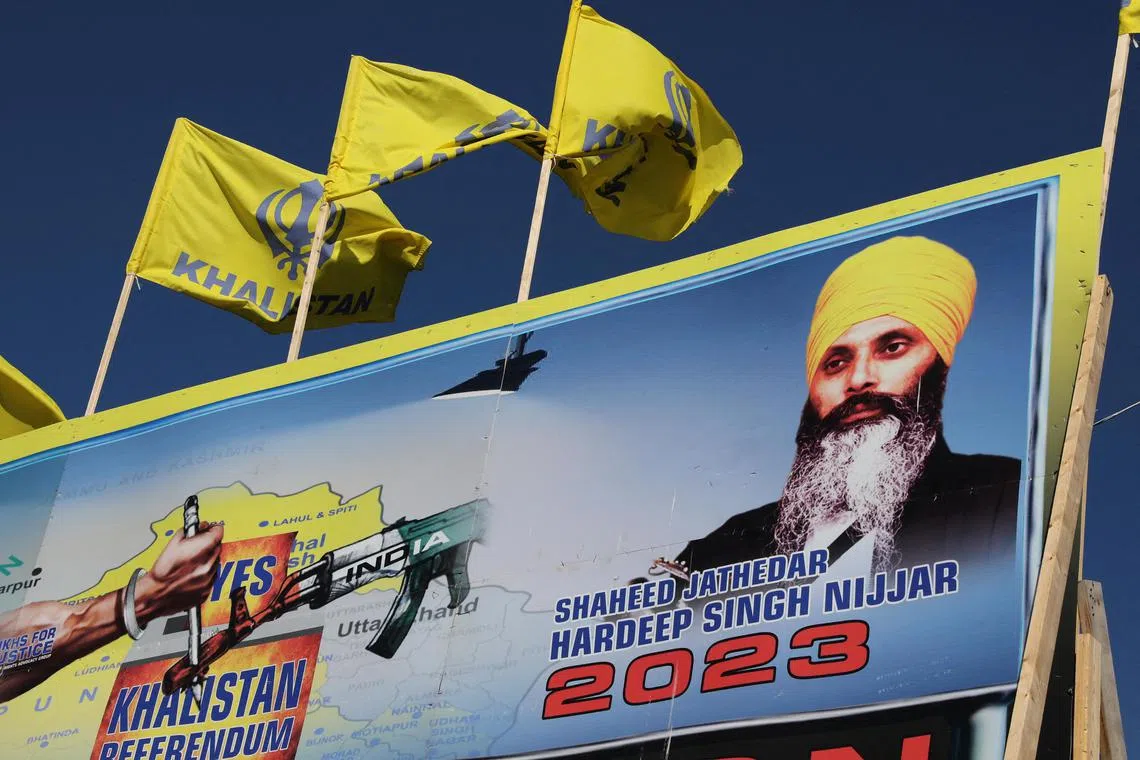Canada’s assassination claim further divides its Indian diaspora
Sign up now: Get ST's newsletters delivered to your inbox

Young members of the Pakistani Sikh minority in Lahore on Sept 20, 2023, holding placards during a protest against India over Mr Nijjar's murder in Canada. The Sikh independence movement seeks to establish a separate homeland for Sikhs in South Asia.
PHOTO: EPA-EFE
Follow topic:
TORONTO – The stunning allegation that India was behind the assassination of a Sikh separatist leader
It is pitting staunch Hindu nationalists against supporters of the creation of an independent Sikh state called Khalistan.
In October 2022, in the city of Mississauga, Ontario, police broke up a fight in which one man was slightly injured after a crowd, carrying Indian and Khalistan flags, became unruly during a Diwali celebration.
In March, a Punjabi radio journalist covering a protest in Surrey of an Indian high commissioner’s visit was attacked by demonstrators.
These episodes underscore the challenges that Canada faces following Prime Minister Justin Trudeau’s claim on Monday that India was responsible for the killing of a Canadian Sikh leader.
Mr Hardeep Singh Nijjar was fatally shot in June outside a temple in Surrey,
Mr Trudeau’s allegations have set off a diplomatic skirmish as the country seeks India’s cooperation with its investigation into Mr Nijjar’s killing.
The long-running, tense and sometimes combative relationship between extremists on both sides threatens to spill over into new violence as their members are either empowered or enraged by Mr Trudeau’s allegation.
Canada has long said that anti-India protests by Sikhs, provided they are not violent, are constitutionally protected free speech.
But a senior federal government official, who spoke on the condition of anonymity to discuss sensitive information, said the country recognises that there is a need to find a way to rein in more extreme and inflammatory actions.
Canada is home to the world’s largest Sikh population outside India. They constitute about 2.1 per cent of the North American country’s total population. At roughly 770,000 people, Sikhs make up just over half of all people with Indian heritage in Canada.
An episode in June prompted an objection from Indian Foreign Minister S. Jaishankar. That month, a march in Brampton, Ontario, a city west of Toronto, included a parade float presented by Sikh nationalists that mocked the assassination of prime minister Indira Gandhi, who was killed in 1984 by two of her Sikh bodyguards.
Speaking at a news conference several days later in New Delhi, Mr Jaishankar called attention to a video on social media that showed the parade float. “I think it’s not good for the relationship, and I think it’s not good for Canada,” he said.
In July 2022, the murder of another Sikh man stoked fears of targeted killings in the Sikh community in Surrey.

Mr Hardeep Singh Nijjar was fatally shot in June outside a temple in Surrey, a suburb of Vancouver.
PHOTO: REUTERS
Mr Ripudaman Singh Malik, 75, was fatally shot in daylight by two men in their 20s whom the police later charged with first-degree murder.
Mr Malik was one of the men accused in the 1985 Air India bombing that killed 329 people aboard a flight to India from Canada.
He was acquitted in 2005 in a lengthy trial that came after the death of many witnesses – some of whom were murdered. Other witnesses were intimidated into not testifying.
Mr Malik’s shooting prompted Mr Balpreet Singh Boparai, a Toronto-based lawyer for the World Sikh Organisation, to approach the Canadian Security Intelligence Service, Canada’s spy agency, with his concerns about the safety of Mr Nijjar and other Sikh activists, he said. He also said he had spoken to local police.
“I had expressed concerns generally about Indian interference in Canada, but also of Sikh activists being targeted,” said Mr Boparai. The statement from Mr Trudeau, he said, validated the community’s fears.
“Sikhs have talked about foreign interference, specifically Indian interference here in Canada, for decades and this is a lived reality for our community,” Mr Boparai said. “But often, this was just written off as conspiracy theories.”
Such stories have swirled around the Sikh community for decades, Mr Mukhbir Singh, a director of the World Sikh Organisation, told reporters during a news conference in Ottawa on Tuesday.
“The younger generation that grew up in Canada, they grew up hearing stories about the persecution, of fear, of speaking out a little too much and you might get on a list or be targeted,” he said. “To see that happening right now in 2023, in Canada, it’s certainly shocking.”
In India, the actions of Prime Minister Narendra Modi’s government seemed to escalate the matter, and the news cycle was dominated by diplomatic tensions.
The Indian Foreign Ministry issued a strongly worded travel advisory
India’s National Investigation Agency posted the photos and names of possible suspects on social media platform X, saying it was intensifying a “CRACKDOWN ON KHALISTANI TERRORISTS OPERATING in India”.
In the flood of misinformation dominating Indian information space in such moments of heightened nationalism, ascertaining just how many of the names included in the post actually had ties to Canada was difficult.
Speaking with reporters, Mr Dominic LeBlanc, Canada’s Minister of Public Safety, dismissed India’s travel warning. “People can read into that what they want,” he told reporters in Ottawa. “Canada is a safe country. What we’re doing is ensuring there’s an appropriate criminal investigation into these circumstances.”
He said that releasing any further information at this point could jeopardise the work of the Royal Canadian Mounted Police. NYTIMES

